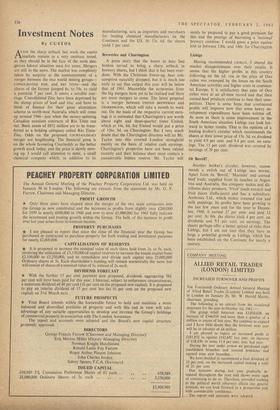Investment Notes
By CUSTOS ATER the sharp setback last week the equity markets remain in a very cautious mood, as they should be in the face of the most dan- gerous labour situation seen for years. Mergers are still in the news. The market was completely taken by surprise at the announcement of a merger between the two world mining groups— CONSOLIDATED ZINC and RIO TINTO—and the shares of the former jumped 6s. to 54s. to yield a potential 7 per cent. It seems a sensible mar- riage. Consolidated Zinc have been depressed by the slump prices of lead and zinc and have to think of finance for their great aluminium scheme in north-west Australia which will come up around 1966—just when the money-spinning Canadian uranium contracts of Rio Tinto run out. Book assets of £871 million are to be trans- ferred to a holding company called Rio Tinto- Zinc. Odds on the proposed COURTAULDS-ICI merger are lengthening. The financial press is on the whole favouring Courtaulds as the better growth stock today, and the price is slowly mov- ing up. I would call attention to BERK, a small chemical company which, in addition to its
manufacturing, acts as importers and merchants for leading chemical manufacturers on the Continent and the US. At 13s. 6d. the shares yield 5 per cent.
Breweries and Charrington.
A press story that the boom in beer had broken served to bring a sharp setback in brewery shares, but I think that it has been over- done. With the Christmas freeze-up, beer con- sumption naturally dropped, but it is much too early to say that output this year will be below that of 1961. Meanwhile the economies from the big mergers have yet to be realised and there are more mergers to come. The latest proposal is a merger between UNITED BREWERIES and CHARRINGTON, which will take a month to work out. On the basis of the respective current earn- ings it is estimated that Charrington's are worth about eight and three-quarter times United, which at 14s. 6d. for United would put a price of 126s. 9d. on Charrington. But I very much doubt that the Charrington directors will let Mr. Taylor into this coveted London stronghold merely on the basis of relative cash earnings. Charrington's properties have not been valued recently and their balance sheet must contain a considerable hidden reserve. Mr. Taylor will surely be prepared to pay a good premium for this and the prestige of becoming a 'national' brewery combine. I would guess a price equiva- lent to between 130s. and 140s. for Charrington.
Liebigs Having recommended Limos, I shared the market disappointment over their results. It seems that the higher profits in this country following on the Id. rise in the price of Oxo cubes was swamped by the losses on the South American activities and higher costs in continen- tal Europe. It is satisfactory that sales of Oxo cubes were at an all-time record and that their corned-beef products continue to beat their com- petitors. There is some hope that continental profits will improve now that some heavy de- velopment expenditures have been written off. As soon as there is some improvement in the South American situation Liebigs can look for- ward to better results. 'That is the opinion of a leading broker's circular which recommends the shares at their lower price of 15s. 3d. ex dividend to yield 4.9 per cent. and 9.4 per cent. on earn- ings. The 15 per cent. dividend was covered by earnings of 29 per cent.
Or Bovril?
Another broker's circular, however, recom- mends a switch out of Liebigs into BOVRIL. Apart from its 'Bovril,' Marmite' and corned- beef trade, supplied from its ranches in Argen- tina and Australia, this company makes and dis- tributes dairy products, Tirol' (malt extract) and fruit juices (Jaffa-juice) and has a subsidiary, Ambrosia Ltd., which makes creamed rice and milk puddings. Its profits have been growing in the last few years and for the year to Decem- ber, 1960, it earned 27 per cent. and paid 12 per cent. At 60s. the shares yield 4 per cent. on dividends and 9.1 per cent. on earnings. The shares perhaps offer a better spread of risks than Liebigs, but I am not sure that they have as large a potential growth as Liebigs, which has been established on the Continent for nearly a century.


































 Previous page
Previous page